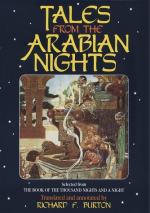[FN#21] Arab. “’Atik”: the superficial similiarity of the words have produced a new noun in Arabic, e.g. Abu Antika = father of antiquities, a vendor of such articles mostly modern, “brand-new and intensely old.”
[FN#22] In the text “Ashkhas” (plural of Shakhs) vulgarly used, throughout India, Persia and other Moslem realms, in the sense of persons or individuals. For its lit. sig. see vols. iii. 26; and viii. 159. The H. V. follows Galland in changing to pedestals the Arab thrones, and makes the silken hanging a “piece of white satin” which covers the unoccupied base.
[FN#23] The blessed or well-omened: in these days it is mostly a servile name, e.g. Sidi Mubarak Bombay. See vol. ix. 58,330.
[FN#24] In the test “Min” for “Man,” a Syro-Egyptian form common throughout this Ms.
[FN#25] “Ay Ni’am,” an emphatic and now vulgar expression.
[FN#26] The Ms. here has “’Imarah” = a building, probably a clerical error for Magharah,” a cave, a souterrain.
[FN#27] Arab, “Zahab-ramli,” explained in “Alaeddin.” So Al-Mutanabbi sang:—
“I become not of them because homed in their
ground: * Sandy
earth is the gangue
wherein gold is found.”
[FN#28] Walimah prop. = a marriage-feast. For the different kinds of entertainments see vols. vi. 74; viii. 231.
[FN#29] Arab. Mukattai al-Yadayn, a servile posture: see vols. iii. 218; ix. 320.
[FN#30] Here the Arabic has the advantage of the English; “Shakhs” meaning either a person or an image. See supra, p. 11.
[FN#31] Arab. “Kawariji = one who uses the paddle, a paddler, a rower.
[FN#32] In the Third Kalandar’s Tale (vol. i. 143) Prince ’Ajib is forbidden to call upon the name of Allah, under pain of upsetting the skiff paddled by the man of brass. Here the detail is omitted.
[FN#33] Arab. “Wahsh,” which Galland translates “Tiger,” and is followed by his Hind. translator.
[FN#34] Arab. “Laffa ’l-isnayn bi-zulumati-h,” the latter word = Khurtum, the trunk of an elephant, from Zalm = the dewlap of sheep or goat.
[FN#35] In the text “Yamin,” a copyist’s error, which can mean nothing else but “Yasimin.”
[FN#36] The H. V. rejects this detail for “a single piece of mother-o’-pearl twelve yards long,” etc. Galland has une seule ecaille de poisson. In my friend M. Zotenberg’s admirable translation of Tabara (i. 52) we read of a bridge at Baghdad made of the ribs of Og bin ’Unk (= Og of the Neck), the fabled King of Bashan.
[FN#37] I have noted that this is the primitive attire of Eastern man in all hot climates, and that it still holds its ground in that grand survival of heathenry, the Meccan Pilgrimage. In Galland the four strips are of taffetas jaune, the Hind. “Tafti.”
[FN#38] The word is Hizam = girdle, sash, waist-belt, which Galland turns into nappes. The object of the cloths edged with gems and gums was to form a barrier excluding hostile Jinns: the European magician usually drew a magic circle.




